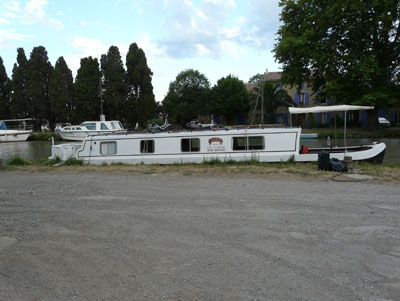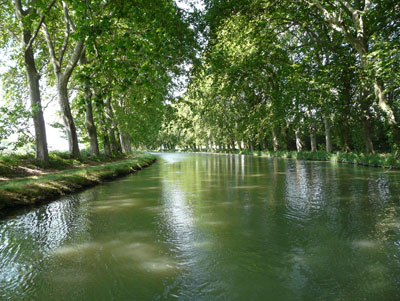Narrowboat on Canal du Midi
Cruising the canals of Europe in a narrowboat and seeing a part of the continent that not too many people see was a dream of mine. I liked the idea of operating a boat by ourselves rather than being on a floating hotel, and going at the high speed of two to three miles per hour would be easy.
My traveling companion, Pam, and I decided to rent a narrowboat for a week and tour an area of southern France. Incidentally, the amount of French that we could speak was very tiny.
Internet research revealed many companies offering cabin cruisers for rent, but narrowboats seemed to me to be more intriguing and we could find only one company in France that had these. Minervois Cruisers (Napton Marina, Stockton, Southam, Warwickshire, CV47 8HX, U.K.; phone +44 [0] 1926 811842, www.minervoiscruisers.com or www.boatinginfrance.com) is based in the UK but has some boats in the south of France.
In January, I made a reservation for July 19-26, 2008, and paid 40% of the fees to the company. The basic cost for the boat and insurance was £1,247 (near $1,815) for one week. It was a little confusing, with some of the fees in pounds and others in euros. A few months later I paid the remainder, excluding some optional fees that had to be paid when we arrived at the boatyard in southern France.
These optional fees included E10 ($12) for towel rentals, E20 ($25) for a map/guide (which proved very helpful and is an excellent souvenir) and E40 per week for bike rental. If you bring along a domestic animal, it’s an extra E50. The diesel fuel used depends on how far you drive the boat, but the average cost is E120 ($155) for the week.
We took a train from Paris south to the fortified walled city of Carcassonne, which I thought would be a more interesting place to stay than Narbonne, which was closer to our departure point. The night was spent at Les Florentines (71, rue Trivalle, 11000 Carcassonne, France; phone 06 86 95 65 75, www.lesflorentines.net), a 6-room B&B located about 400 yards outside the town walls.
I would have liked to have stayed within the Old Town walls, but a B&B owner told me that during the summer months there was a 2-night requirement for weekend stays for all B&Bs inside the walls.
At E110 per night for two, we had the most expensive room on the top floor (four flights of walkup), with two patios, one overlooking the city proper and the other looking out at the walls of the fortified section of town.
After touring Carcassonne, we proceeded to Narbonne by train in the afternoon. We then took a cab about 12 miles north to Le Somail and the boatyard on the Canal du Midi, a once-major thoroughfare through France.
Originally opened in 1681, the canal was a connector between the Atlantic port of Bordeaux and the Mediterranean Sea near Marseilles and eliminated the need to go through the Strait of Gibraltar. It was the first aqueduct navigable by ship, had the first canal tunnel and has operated for over three centuries without significant improvement. Part of it was dug with the “assistance” of English prisoners of war.
Although there may be a few commercial operations still using this waterway, today the highest use is recreation oriented. The canal itself is on the UNESCO World Heritage Sites list.
After we found Minervois Cruisers, the personable manager, Tony, showed us our narrowboat, the St. Chinian, 46 feet long and 6'9" in width. He spent some time giving us all the do’s and don’ts and general operating instructions. A thick reference book stayed on board that duplicated everything he talked about.
Tony took us out for a trial spin. I quickly got the hang of steering, and after I made a couple of practice U-turns he jumped ashore and said, “She’s all yours.”
Steering is conducted by a long tiller controlling the rudder. Ours was about the only boat we saw that didn’t have a steering wheel. There is a speed limit of 8 kilometers an hour (5 mph) on the canal, but we were really zooming if we went 4 kph.
We proceeded up the canal at the magnificent speed of 3.2 kph (2 mph) in the general direction of Béziers. People walking along the towpath were going faster, but that didn’t matter to us.
The towpath was used by walkers, bicyclists, horseback riders and runners. One individual was pulling his camping gear behind him in a modified golf cart. He would pass us, and after a while he would stop for a while and we would pass him. As he passed us again he would smile and wave.
Most of the canal’s aquatic life consists of eels and catfish. Over the week we also saw a turtle, egrets and a small, nutria-like rodent swimming across the canal. Centuries of muck line the bottom.
After an hour or so, the events of the day and jet lag took their toll and we decided to call it a day. You can moor almost anywhere you want along the canal. The easiest way to do this is to loop the mooring line around the roots of one of the many trees that line the canal. A few figure-8 loops on the boat cleats with the forward and rear mooring lines and you are secured.
Another way is to drive stakes into the ground and wrap the mooring lines around them. We did see a few mooring posts along the way, but we were able to avail ourselves of them only once.
On board the St. Chinian we had a refrigerator, a gas stove/oven and utensils for cooking, eating and cleaning.
The head had a shower, toilet and sink all nestled into a very cozy space. All of the boats that use this canal dump their bathroom sewage directly into the water. For this reason, the rental company advises not swimming, even though we saw a few people (presumably locals) doing so.
Our boat was large enough for two couples, with a bed and also a futon that converted into a bed. Since Pam and I are not a “couple,” this worked out fine, with her taking the bed and me on the futon. I believe that four people would be crowded on the St. Chinian.
Because, while mooring, someone is needed to handle the lines and another person is needed at the tiller, a minimum of two people is mandatory on this boat.
The next day we moored at the small town of Capestang. We were able to avail ourselves of a small but complete grocery store that obviously saw a lot of boaters. We became accustomed to the French habit of eating late in the evening in the restaurants, even though our stomachs might start growling around 6.
Later we moored near Colombiers, with one line wrapped around a tree root and one attached into a stake driven into the ground. We took our bicycles into town, stocking up on drinking water and supplies. Dinner that night consisted of tapas and sangria from a Spanish restaurant.
The next morning after she woke up, Pam stuck her head out the window and yelled, “Lynn, there are no mooring lines and we are on the opposite side of the canal!”
The tree root that we wrapped the forward mooring line around had come completely out of the mud and was not attached to the tree. Pulling the mooring line back on board, I saw that the rear mooring stake had also come loose and we were adrift! Luckily, there was no boating allowed on the canal after dark or we could have been hit.
After pulling the rear mooring line back on board, I grabbed the key, started up the engine and found out that the transmission was broken! I could not put the propeller into gear.
By swinging the tiller back and forth, I was able to bring the boat back over to the side of the canal where the towpath was located. Pam jumped ashore with the rear mooring line but couldn’t let go to find a tree root to wrap the line around. (There were none in the area anyway.) She pulled the rear of the boat to the shore, but that made the front end swing out into the canal.
Luckily, a jogger stopped to help. I tossed him the line and he pulled the front of the boat to shore. Jumping ashore, I drove two stakes deep into the ground and we moored the boat.
Before the trip started, I had picked up a cell phone that operated in France. We called the rental company, and an hour later Tony showed up with a new transmission setup. It took him about half an hour to install it and we were off again.
We didn’t proceed far. There was a series of locks (called a staircase) that dropped the canal into Béziers and we didn’t have the time or inclination to handle them, so we conducted a U-turn. We stayed near Colombiers again, this time making sure that our stakes were driven well into the ground, and toured around the area. Pam rode her bike and I walked.
We continued on to Capestang, near where we had stayed during our second night out, and enjoyed a local restaurant. I did stay away from the offered catfish, figuring there was a chance it came from the canal.
We returned to near Le Somail on Friday afternoon. The boat had to be returned by 9 o’clock the next morning.
Pulling into our final berth was a cinch. After a quick check, Tony filled up the diesel tank and charged us for what we had used: only 35 liters for a week’s worth of touring. His wife and co-manager, Emily, said that it was a new record for the least amount of fuel used. We didn’t care. We had traveled when we wanted to, stayed when we wanted to, had some adventures and just thoroughly enjoyed ourselves and the trip. The locals were a delight to talk to and were always ready to help with directions or information.
Mmm, maybe Wales or Ireland for our next boating trip?
LYNN A. CLEMONS
Winnemucca, NV


